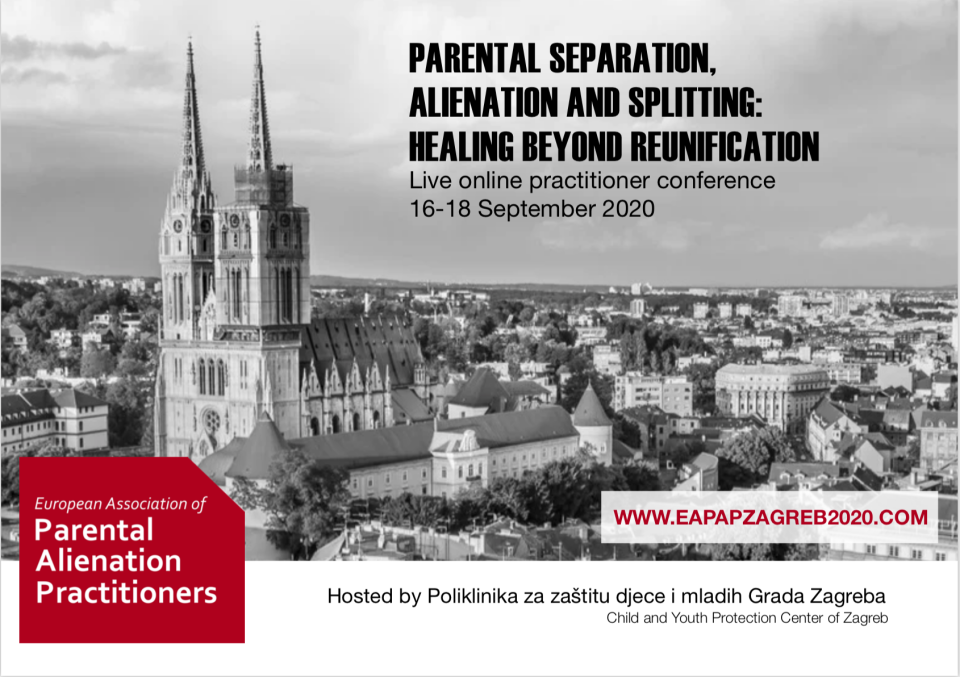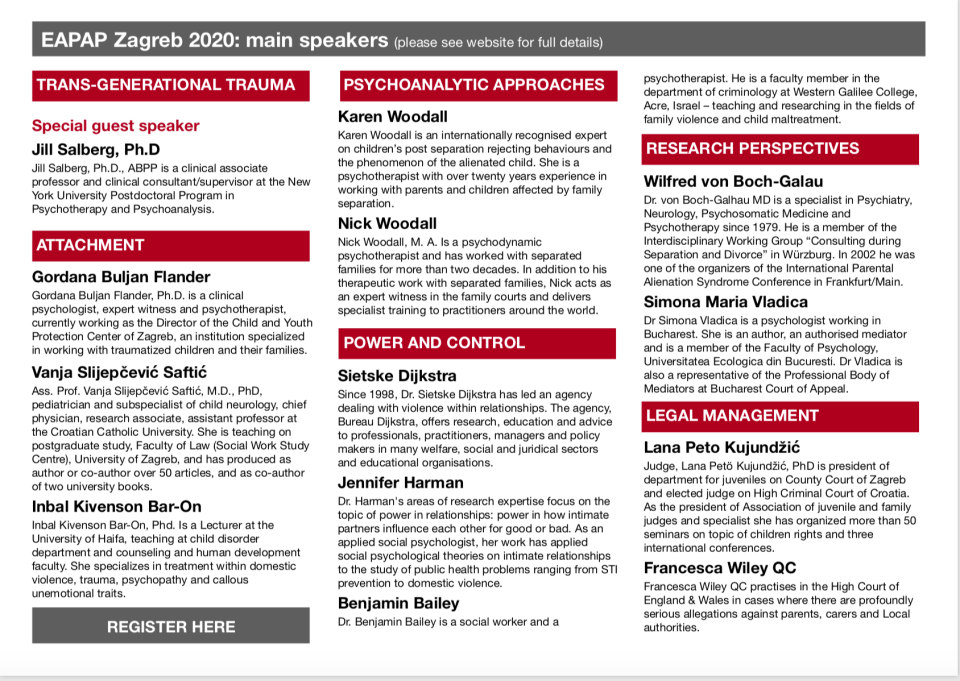Working with other clinicians allows me to formulate new way of educating others about how to approach cases of a child being induced to use psychological splitting in divorce and separation. Lately we have been discussing how to help social workers, people we often work with in teams, to understand the concept of alienation using the idea of non accidental injury to the mind of a child.
I have also been discussing how to use the treatment approach to helping abused women and men to break free from the harm they are experiencing and how this relates to alienation in children.
Constrain, protect and treat is an easy way to think about the formula we are using in alienation. It is the same formula as that used in non accidental injury cases by social workers and by people working with survivors of domestic abuse.
This formula translates well for those who are working in this field therapeutically, it helps to clarify how such interventions should be made and why they should be made in this order. Let’s begin with the formula and its use in non accidental injury and domestic abuse.
In times of crisis we do not offer therapy. Crisis prevents people from being able to reflect upon their experience and is ineffective and at times harmful to them as it expects them to have the capacity to do something they are incapable of (no-one can reflect upon their world when they are dysregulated).
Constrain
When a child has suffered non accidental injury, our first action is to constrain the person who has caused this. When someone is suffering domestic abuse, our first action is to find ways to constrain the perpetrator (whilst supporting the person to find practical ways out of the situation). In alienation of a child, we do not expect a child to enter into therapy without constraining the person who is causing the problem.
Step 1 – Constrain – Ensure that the influencing parent is prevented from controlling the child.
Protect
When a child has suffered non accidental injury, we build a protective space for the child to live in. When someone has experienced domestic abuse we build a route to a protected space for them to feel safe in. When a child has been alienated, we focus upon ensuring that a protected space is made for them which is away from the parent who has caused the problem.
Step 2 – Protect – Ensure that the child is enabled to spend time in protected space, away from the parent who is causing the problem.
Apply Therapy
When a child has suffered non accidental injury, we utilise the protected space to apply therapeutic work. When a domestic abuse survivor is in protected space, we offer therapeutic support to review and rebuild life. When a child is in protected space, we offer proximity to the parent they have rejected and utilise that proximity to apply therapeutic input.
Step 3 – Apply therapy – Ensure that the child is enabled to be in close proximity to the parent they have rejected and apply therapeutic input alongside this.
Differentiating Alienation
A child’s rejecting behaviour in divorce and separation is differentiated by the use of psychological splitting.
If a child is not utilising psychological splitting, is able to see the good and bad in their parents, is able to move between them, they are not alienated. They may be suffering from switching behaviours, compartmentalisation behaviours, maladaptive behaviours, but they are not alienated.
If the child divides parents into idealised and demonised and if the child’s demonisation of a parent echoes the influencing parent’s beliefs and if the rejected parent is evidenced as not having done anything which could cause such strong division of feeling, then alienation is possible.
The Court is the place where alienation of a child is decided upon after hearing the evidence. Recent UK High Court Court judgments have made it clear that the issue of alienation is a child protection issue, regardless of whether that is done consciously or unconsciously.
The mental health intervention is held in place by the court system.
Delivering therapeutic work outside of that is contraindicated by the research evidence and potentially causes further harm.
Importance of correct formula in treatment
Why must we treat alienation as we would non accidental injury and domestic abuse when we are working as therapists? Because the child is in the same position as all abused children/people, they are identifying with the aggressor. To place the child into that double bind, is, as Dr Steve Miller* explains, to re-injure the child.
- In non accidental injury the child will forgive the parent and seek to blame the self for the harm done to them.
- In domestic abuse, the person will try to find ways to internalise their responsibility for what is happening to them in order to justify staying.
- In alienation the child will split off and deny their experience in order to avoid the threat of abandonment.
Abandonment threat is wrapped up in what looks like love in many cases of alienation but in some cases it is starkly present and easy to detect. Being able to differentiate this identification with the aggressor dynamic in children’s rejection of a parent, is critical in helping the outside world to understand the threat to the child.
As we continue in our work to educate other practitioners, being able to clearly articulate the problem of induced psychological splitting in children and how to treat it, is an essential task.
This is our project, the EAPAP Conference will roll this out around the world.
*Miller (2013, p. 16) who notes that, ‘therapists who insist on a trial of conventional therapy (e.g., to ‘see for myself’) are exceedingly unlikely to succeed (…) such an approach is worse than worthless because while the therapist provides futile treatment, the child, already injured, is deprived of effective intervention–including protection’
To Register for the Online EAPAP Conference click here






Excellent topic and well explained with actions to secure the psychological abuse of the child/children by the aggressor/Alienator. My concern is SW should be FULLY aware of the impact of PA on children. This hand holding is basically a get out of jail card for many rotten corrupt SW who do all they can to destroy the children by destroying the relationship they have with their alienated parent mainly the father. What is required is the judiciary handing down prison sentences to SW who are guilty of advocating child abuse – PA and child murder or placing children into adoption or foster homes where the child is placed in an environment of risk. I’m sure there will be screams of opposition to the above by those SW who are in a profession they should never have been employed in but alas they know they are untouchable and free from any form of retribution by the victims. The same form of justice should be handed down to crooked psychologists who are also guilty of the same shocking conduct. Only then will the system be fit for purpose..
LikeLike
Thank you for this article.
Kindest regards,
Pam
LikeLike
Karen: As we discussed, we thought it would be a good idea to post the following:
Can a child still split if both parents are equally disparaging the other parent or causing psychological abuse? In other words, the child goes along with each parent in their home. For example, when with mom, they agree with everything she says about dad. And When With dad, they agree with him about everything he says about mom.
In fact, I actually have cases where both parents are alienators. The mother alienating the daughter from the father. And the father alienating the son from the mother.
LikeLike
Hi Joan, thanks for posting the question.
Yes a child can use the defence of splitting in the scenario of both parents alienating. Splitting will cause alignment with one and rejection of the other. In the case of two parents alienating, they are fighting for possession of the mind and body of a child to compensate themselves for the loss of the relationship or loss of control over the other person. Again defences.
A child who is different in each parent’s home to this degree is using switching behaviour which is the precursor to splitting. It is a defence which is caused by immense psychological pressure on a child. Anyone who works with two parents who describe two very different children, should be alert to the very high risk of splitting occurring. Splitting causes the child to refuse to see a parent, to align powerfully with one and reject the other. Switching allows the child to still move between two parents but usually not for long. Switching doesn’t have to precede splitting, splitting can occur in a second – usually preceded by a trigger event which causes the child to feel they can no longer cope – parents will often describe this as some kind of crisis – referring to it as ‘(trigger)gate’. ie: Chickengate, after a fight over chickens between parents, Holidaygate, after the child had a great holiday with a parent, went back to the other parent and was never seen again, canoe gate, after a child enjoyed canoeing with a parent and step parent, went back to the other and raved about how great it was and was never seen again.
Trigger events are the events which cause the influencing parent to dysregulate and convey the message to the child that it is not ok to love the other parent – this causes abandonment threat in the child who must then split off their conscious awareness of what is happening, translate their feelings of fear of the influencing parent’s behaviours into understanding, align with that parent and then join them in often very vocal hatred of the other parent.
This is a psychological defence, which is readily described in the psychoanalytical literature and which can be treated using the constrain, protect and treat protocol. When the influencing parent is constrained, when the child is protected, then using trauma based approaches to reconnect the child to the parent they have rejected – who by the way is NOT abusive, violent or dangerous and never was – if they were it is not alienation. Worth saying that as often as possible given what is going on in the UK right now in terms of misinformation. K
LikeLike
Excellent excellent point..this is one area of child abuse not given consideration – toxic divorced parents. I must say, I so value this forum. Being an alienated father – no gender bias but in Guernsey 99 out of every 100 fathers who find themselves fighting to see their children are alienated from their children and Visa versa. It’s been admitted by members of the judiciary and others our system is broken and in crisis..Male suicide is the higher or head capita then the whole of the UK..We need the outside world to sit up and take notice..We have high level phedofiles who are masons or well connected that literally walk free from any prosecution with the blessing of the system…it was allegedthe nspcc left Guernsey because of the high level of child abuse but were helpless to act due to corruption..
LikeLike